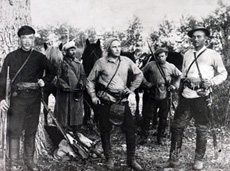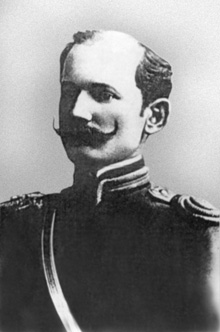|
 In Tuva, Sergei Kuzmich Kochetov is a legendary personality. The village where he spent his youth and one of the central streets in Kyzyl bear his name. He was a participant in three wars – The World War I, the Civil War, and the Great Patriotic War. He fought at Moscow, battled at Kursk, liberated Kiev. When he returned to Kyzyl, he became the first delegate to the Supreme Soviet of USSR from the republic. Sergei Kochetov was born on November 7, 1894 in the Kodybai village of Minusinsk district. In Tuva, Sergei Kuzmich Kochetov is a legendary personality. The village where he spent his youth and one of the central streets in Kyzyl bear his name. He was a participant in three wars – The World War I, the Civil War, and the Great Patriotic War. He fought at Moscow, battled at Kursk, liberated Kiev. When he returned to Kyzyl, he became the first delegate to the Supreme Soviet of USSR from the republic. Sergei Kochetov was born on November 7, 1894 in the Kodybai village of Minusinsk district.
 In 1914, the family moved to Tuva and settled in Atamanovka. Sergei, just like his father, worked as a carpenter, farmed was friends with the local arats, spoke the Tuvan language very well, and also became a Russian language teacher for Oyun Kursedi. In 1914, the family moved to Tuva and settled in Atamanovka. Sergei, just like his father, worked as a carpenter, farmed was friends with the local arats, spoke the Tuvan language very well, and also became a Russian language teacher for Oyun Kursedi.
Kochetov organized the first Red Guard detachment in Tuva. It consisted of six companies of 100 bayonets each, and a cavalry squadron. It was precisely Kochetov’s detachment that defeated the army of the White Guard general Bakich, which outnumbered the detachment of Red Partisans four times.
In the memories of his friends, Kochetov was a very sociable person, and behind a “glass of tea” loved to remember the old days. There is one episode that he hardly ever told to anyone, which is connected with the astonishing victory of the red partisans over the army of general Bakich, right by Kochetov’s village - Atamanovka – in 1921. One of the chosen few who had heard this story, was a Kyzyl pensioner Vasili Afanasyevich Merzlyakov, who for many years headed the Tuvan regional soviet of professional unions.
…The success of this operation was always ascribed by professional historians to the exceptional bravery and perseverance of the partisans of Kochetov’s detachment. The red commander himself, only just before his death, admitted that the victory over the Whites at Atamanovka was successful mainly thanks to the resourceful activities of his spies.
The main point was that the spies managed to kidnap Bakich’s beautiful wife, who was always by the general’s side and knew all the plans of the White Guard. The spies of the White Guard insisted that there are practically no red Partisans in Uriangkhai, and that regardless of the fact that Tuvan Partisans, in March of 1921, destroyed the Chinese detachments at Das-Uzhu near Shagonar and in the valley of Chadaana river. The leader of the Chinese, Lin-Wan saved himself by running away. Trusting the reports of their spies, Bakich led his army to the territory of Uriangkhai regiuon, not even imagining what strong opposition he would run into encountering Kochetov’s Partisans.
Bakich did not know that even in 1918, Kochetov organized a mobile partisan detachment in the Podkhrebetskii region (now Tandy region of Tuva). The battle experience, obtained at the fronts of the WWI, helped him to organize a mighty detachment of Russian and Tuvan men, out of whoever had a firearm, a saber and a horse.
A life of a partsan is special. One day you are simply a farmer, shepherd or hunter, but tomorrow you can become a fighter. The partisan always had his weapon and his horse, even when working in the fields. The partisans would be called together by a relay, the headquarters were in Atamanovka. It took a certain number of hours to gather all the partisans from widely scattered areas from Berezovka, Bai-Khaak, Argolik, Mezhegei, and other tiny settlements, into a fighting formation.
It is possible that this is why Bakich’s spies reported that there are no partisan armies in Tuva. This lack of appreciation of the partisan detachments led to a complete rout of all the White Guard groups.
 Well, one morning General Bakich woke up and his wife was gone. Where could she be? She disappeared! She was stolen by Kochetov’s spies. The beauty held up proudly during interrogation. “I will,- said she cuttingly,- speak only to the commander himself!” Well, one morning General Bakich woke up and his wife was gone. Where could she be? She disappeared! She was stolen by Kochetov’s spies. The beauty held up proudly during interrogation. “I will,- said she cuttingly,- speak only to the commander himself!”
Kochetov remained alone face to face with her. And what she told him, the red commander told this way: “I will tell you all the General’s plans only after you promise to marry me.”
The red commander had to promise to fulfill her request, which was, anyway, practically impossible, because Sergei Kuzmich was married already… Well, and good memory, knowledge of the maps of the disposition of the forces, daily attendance at the meetings of the headquarters, of the general allowed Bakich’s wife to accurately describe the composition of the white armies. Thanks to the reports received from Bakich’s wife, Bakich’s army was surrounded and destroyed near the little village Ak-Kezhik. Bakich himself was captured and after being sentenced by the tribunal, was shot.
When the partisans were celebrating their victory, Kochetov tried to think about how to satisfy the promise given to the general’s wife. She insisted on a wedding, and it took place. But…As the guests started to gather and drink, one of the partisans jumped on his horse,and rode to Atamanovka to Sergei Kochetov’s wife Olga. “You’re sitting here, and meanwhile your Seryozha is getting married to a White Guard beauty!”
Olga jumped on a war horse, armed herself with a saber and a revolver, and in half an hour she was already in Ak-Kezhik. She kicked open the door of the building where the noisy wedding was proceeding, and wanted to shoot the groom and the bride right from the doorstep. But somebody grabbed her hand just in time, the gunshot ended up in the ceiling.
“The cruel atamaness”, as the partisans called Bakich’s wife, could not calm down for a long time. In the end there was nothing else to be done but to hide her away. He took her to Turan, a town located on the administrative border with the Krasnoyarsk region, under the pretext of of sending the “atamaness” further away to the prison in Minusinsk as a war captive. But, as he was taking her to Turan, Kochetov changed his mind. He realized that he could not separate from his new love so quickly. Being with this very beautiful woman ( Kuzmich, unfortunately, never told anyone her name), who trusted him as a man, became as necessary to him as breathing. Kochetov left her in the care of Russian Orthodox priest in a church in Turan, and returned to Atamanovka to his lawful wife. But he could be observed quite often running on his horse to Turan, to meet his “cruel atamaness”. This lasted for several months.
One day a rumor reached the commander that the bell-ringer of the church, a big red-haired guy, was not just courting his new beloved, but also had entered into very “close” relations with her. Kochetov dropped everything and showed up in the church in Turan and started setting things in order. Finding out about Kochetov’s arrival, the bell-ringer hid so well that Sergei Kuzmich could not find him for several days. But when he finally found him, he explained, and not just verbally, that it was not possible to court this woman. The bell-ringer promised never to approach Kochetov’s mistress again.
And he kept his word.
The beauty who fell in love with Kochetov stayed alone. The rare meetings with the Red Commander were not enough for her. She suffered when he was not next to her. The last time she was seen she was sitting on a cart being taken to Minusinsk, to the psychiatric hospital. With her eyes cast down, she was meekly sorting small quadrangular pieces of paper, counting them as if they were banknotes, and quietly kept talking to herself.
That is how the love affair ended, but it stayed in the memory of the hero of three wars for the rest of his life. Kochetov even recorded it on tape. Sergei Kuzmich had just one request – that the story would not be published as long as his wife Olga was alive. And that is the way it was done. The story was published in the newspaper “Vechernyi Krasnoyarsk” on May 13, 2005.
It is interesting that under the Shandyg cliff, in the battle with Bakich, the famous Altai artist Choros-Gurkin was also taken prisoner. As Kochetov remembered: “A tall, rough-faced elderly officer without epaulettes, who looked like a Khakass, came up to me and requested medical help if such was available. I told him that he would be taken to Ust-Elegest together with the other wounded, that is where our hospital was. It is interesting that at that time, the name Georgiy Ivanovich Gurkin just did not mean anything to me. According to his documents, he was an adviser in national questions with Bakich’s headquarters. He did not present his weapon, possibly he did not have one. So I sent him away.”
(Gurkin later became a famous landscape painter. He was a student of Ivan Shishkin. His 4-year stay in Tuva until 1925 resulted in his series of paintings +Lakes of Tuva” and “Yenisei”. In 1926, the painter prepared a whole series of paintings “Geological composition of Tannu-Tuva mountains” for the Leningrad Geological museum of AN SSSR.)
In the 40’s, Atamanovka was renamed to Kochetovo village after the red commander.
The villagers restored the building of the headquarters of the partisan detachment, where the first central khural took place. Currently it is a museum of those times. Historical relics of those events are on exhibit.
Commander Kochetov received three gunshot wounds, four shrapnel wounds, and two concussions at the fronts of the Great Patriotic War. He was awarded the “Order of the Red Star” of the Great Patriotic War of the First Degree, and “Medal of Merit” for bravery and heroism, two orders of TNR. Kochetov lost his son at the front.
On April 29, 1945, Sergei Kochetov was unanimously elected as a delegate to the Soviet of the Nationalities of the Supreme Soviet of SSSR. He received the title “Merited Citizen of Kyzyl”. In 1957, Segei Kuzmich died after a serious illness.
By the decision of the State Commission Sergei kuzmich Kochetov’s name was entered in the publication “Merited People of Tuva of the 20th Century”.
Note about General Bakich
General Andrei Bakich commanded the detachment of White Guard in Mongolia under the leadership of Baron Unregn Having taken the Mongolian Urga in 1921, the baron took up the post of Chief of Headquarters of the Mongolian Army and started showin interst in Uriangkhai region. Not only Mongolia but also China continued to count on support of the Uriangkhai population, but as time went on, and by 1921, the orientation of the Uriangkhai population changed. The Tuvans began to choose – who is White, who is Red, who is enemy and who is a friend to the local people. This year was marked by a serious attempt of the White detachments of atamans Kazantsev, Kaygorodov, General Bakich, to take over Tuva. Ungern sent a detachment of General Bakich to Tuva, hoping to conquer the territory without much effort. But the White Guard underestimated the strength of the partisan detachments of Kochetov.
|
|
